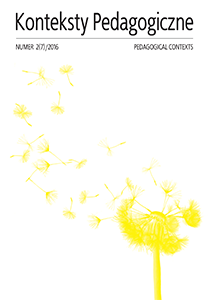Abstrakt
Teoria inteligencji wielorakich zakłada, że każdy człowiek posiada wszystkie typy inteligencji. Inteligencje te wzajemnie na siebie oddziałują, prze-nikają się i współpracują ze sobą, tworząc dynamiczny układ, określany mianem profilu inteligencji. Profil inteligencji opisuje charakterystyczną dla każdego kombinację mniej lub bardziej rozwiniętych rodzajów inteligencji wykorzysty-wanych do rozwiązywania różnych problemów. Jedne inteligencje są mocno roz-winięte, inne słabiej, co sprawia, że każdy posiada zarówno mocne, jak i słabe strony. W Gardnerowskiej teorii istotne jest rozumienie świata przez dziecko i dlatego teoria ta stanowi szczególną inspirację dla pedagogów. Poznanie pełnego wachlarza możliwości dziecka to podstawa podejmowania kreatywnych działań sprzyjających rozwojowi dziecka.
Bibliografia
Chen J.Q., Moran S., Gardner H., Multiple Intelligences around the World, San Fran-cisco 2009.
Czaja-Chudyba I., Odkrywanie zdolności dziecka. Koncepcja wielorakich inteligencji w praktyce przedszkolnej i wczesnoszkolnej, Kraków 2005.
https://pl.wiktionary.org/wiki/wachlarz [dostęp: 12.03.2016].
Gardner H., Inteligencje wielorakie. Nowe horyzonty w teorii i praktyce, przeł. A. Jan-kowski, Warszawa 2009.Gardner H., Inteligencje wielorakie. Teoria w praktyce, przeł. A. Jankowski,Poznań 2002.
Gardner H., Zmiana poglądów. Sztuka kształtowania własnych i cudzych przekonań, przeł. M. Łamacz, Kraków 2006.
Gardner H., Kornhaber M.L., Wake W.K., Inteligencja. Wielorakie perspektywy, przeł. M. Groborz, M. Śmieja, Warszawa 2001.
Kaleta-Witusiak M., Kopik A., Walasek-Jarosz B., Techniki gromadzenia i analizy wie-dzy o uczniu. Casebook ze wskazówkami dla praktykantów, Kielce 2013.
Kopik A., Inteligencje wielorakie, [w:] Mały leksykonpedagoga wczesnoszkolnego, red. J. Karbowniczek, Warszawa 2014.
Kopik A., Zatorska M., Wielorakie podróże – edukacja dla dziecka, Kielce 2010.
Poleszak W., Porzak R., Kata G., Kopik A., Diagnoza i wspomaganie w rozwoju dzieci uzdolnionych, Warszawa 2014.
Autor zgodnie z zaleceniem MNiSW, by przeciwdziałać praktykom „ghostwriting” i „guest authorship” składając tekst dołącza oświadczenie Autora/Autorów, w którym deklaruje wkład każdego z Autorów w powstawanie publikacji. Własnoręcznie podpisane oświadczenie należy przesłać na adres redakcji:
Joanna Skibska | w formie skanu przesłać poprzez system OJS (biblioteka wydawcy).
Autorzy nie ponoszą żadnych kosztów w związku z publikacją artykułu na łamach czasopisma Konteksty Pedagogiczne oraz nie otrzymują gratyfikacji finansowej za opublikowanie tekstu. Redakcja zastrzega sobie prawo do wprowadzania niewielkich zmian w artykułach, które nie mają wpływu na merytoryczną stronę publikacji.
Autor (Autorzy) artykułu oświadcza, że przesłane opracowanie nie narusza praw autorskich osób trzecich. Wyraża zgodę na poddanie artykułu procedurze recenzji oraz dokonanie zmian redakcyjnych. Przenosi nieodpłatnie na Wydawnictwo Libron autorskie prawa majątkowe do utworu na polach eksploatacji wymienionych w art. 50 Ustawy z dnia 4 lutego 1994 r. o prawie autorskim i prawach pokrewnych – pod warunkiem, że praca została zaakceptowana do publikacji i opublikowana.
Wydawnictwo Libron posiada autorskie prawa majątkowe do wszystkich treści czasopisma. Zamieszczenie tekstu artykuły w repozytorium, na stronie domowej autora lub na innej stronie jest dozwolone o ile nie wiąże się z pozyskiwaniem korzyści majątkowych, a tekst wyposażony będzie w informacje źródłowe (w tym również tytuł, rok, numer i adres internetowy czasopisma).
Tekst jest udostępniany w internecie na licencji CC-BY-SA

